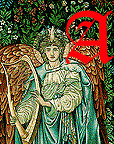
lfred Sacheverel[l] Coke was born on 27 August 1846 at Brimington Hall, a Tudor house now sadly demolished, near Chesterfield, and baptised in the parish church on 23 September that year. He was married at All Saints Margaret Street on 9 November 1875 to Amy Brunton, the daughter of a stockbroker from Tavistock Square, when he gave his address as 22 Margaret St., and his occupation as artist. The church had been rebuilt under William Butterfield in the 1850s and was at the forefront of Tractarian movement. The Vicar had established the Sisters of All Saints Society of the Poor which Maria Rosetti, Dante Gabriel's sister, soon joined. Coke's real address was 5 The Mall, Haverstock Hill, and he had already established himself as part of the Aesthetic movement led by Edward Burne-Jones, Simeon Solomon, Rossetti and others. The Westminster Review in 1869 admired their work but not their technique, dubbing them the "Poetry-without-Grammar School. Other critics were harsher. Initially he exhibited at the Dudley Gallery which promoted watercolours rather than oils, but later he showed at the Royal Academy.
Few of his paintings survive, the earliest maybe a small oil on panel King Edward and Eleanor (1863), a water colour Eros & Ganymede (1869) at the V&A, then oils on canvas Our Lady Mary & Child (1870), Peacocks (1874), Daughter of Herodias (exhibited at RA 1881), St Martin of Tours (exhibited at RA 1887, maybe lost). The first three of these oils are all about 80" by 30", Peacockshorizontal and the other two vertical.
Walter Crane wrote of Coke, "Another comrade was A. Sacheverell Coke, whom in the opinion of one literary man, at least, as confided to me, was 'the best of us' as an artist. He had much facility of design, and sought his subjects in classical mythology, mostly derived rather from the point of view of the early Venetian school as to treatment and colour" (88). Three of his known pictures are however of biblical figures and saints, though his Daughter of Herodias would hardly find a church wall available for its display. His Lady Mary tunnels right back to the Northern Renaissance, rather than "the noble works of the master minds of Italy" (Redgrave 81): for example, like four of Memling's Virgins and one of Eyck's, Mary is shown here in a blue dress with a red cloak. The setting too has echoes of these works. Unfortunately, as Sarah Reynolds says, Coke's work is now "extremely rare."
Coke and his wife Amy had one daughter, Phyllis, who was born in 1878 and died in 1963. He himself died at Weymouth on 23 April 1924.
Additional Information from Dennis T. Lanigan
It is worth adding that Coke's father William Sacheverell Coke J.P., D.L. was a major landowner in Derbyshire, and his family was one of the oldest and best connected in England. His mother Sarah Kift Deane was the daughter of John Deane R.N. The family later moved south: in 1861, when he was about fifteen, the Cokes moved to Clarence Place, Penzance, Cornwall. Alfred entered the Royal Academy Schools to study to become a painter on 22 December 1864 at the age of eighteen. There is no record of when he left the R.A. Schools but at this time the normal length of study would have generally been around five or six years.
Although initially Coke exhibited primarily at the Dudley Gallery, he did exhibit four paintings at the Royal Academy between 1881-1892, primarily classical subjects. He also showed at the Royal Society of British Artists, the Royal Society of Painter-Etchers, the Royal Institute of Oil Painters, and the Royal Institute of Painters in Water Colours. By 1871 he was working as a professional artist and living in St Pancras. In the 1870s he contributed illustrations, along with his friend Robert Bateman, to the People’s Magazine.
Coke joined the Artists’ Rifles and served from 1882-1885. He was a member of “The Fifteen”, a group of artists, decorative designers, and craftsmen formed in 1881 at the instigation of Lewis F. Day. Although this group merged with the Art Worker’s Guild in 1884, Coke never became a member of the Guild itself. He was elected a member of the Royal Institute of Painters in Water Colours in 1883. In 1890 he participated in the 3rd exhibition of the Arts and Crafts Exhibition Society held at the New Gallery.
By 1881 the family was living at 5 The Mall, Park Road, in Haverstock Hill, London. On 19 May 1885 “The Artist’s Ball,” sponsored by the Royal Institute of Painters in Water Colours, was held at the Prince’s Hall in Piccadilly where a Masque of Painters written by Edmund Gosse was performed. The first tableau was a Grecian scene arranged by Coke and it was considered the most successful of the series. By 1889 Coke was living in Totland Bay on the Isle of Wight. As noted above, he died in Dorset in 1924.
Bibliography
"Alfred Sacheverell Coke: Peacocks." Catalogue Note. Sotheby's. Web. https://www.sothebys.com/en/buy/auction/2023/european-british-paintings/peacocks.
Ancestry.co.uk. (where a copy of Coke's marriage certificate can be seen).
Crane, Walter. An Artist's Reminiscences. London: Methuen,, 1907. Internet Archive. Web. 7 June 2025.
Redgrave, Richard, and Samuel Redgrave. A Century of Painters of the British School. London: Phaidon, 1947.
Reynolds, Sarah. "Alfred Sacheverell Coke (fl. 1869-1892)." Peacocks (Lot Essay). Christie's. Web. 7 June 2025. https://www.christies.com/en/lot/lot-6218043.
Created 6 June 2025